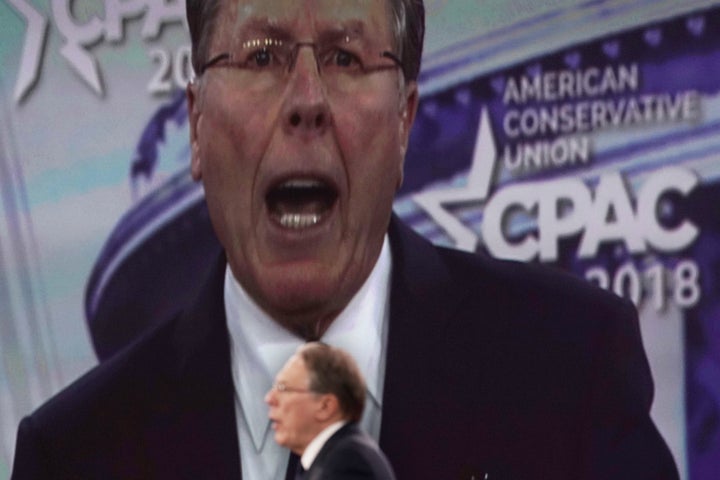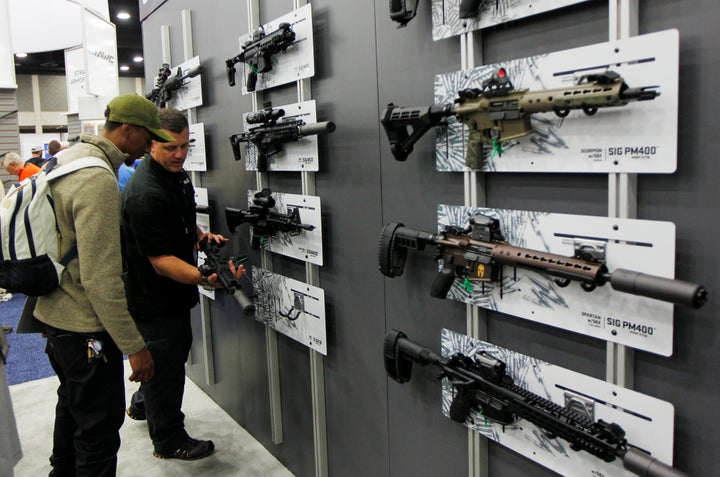
On Thursday, Wayne LaPierre, CEO of the National Rifle Association and unofficial leader of America’s largest cult, took the stage at the Conservative Political Action Conference (CPAC) meeting in Washington, D.C.
In another universe – or maybe even just in another nation – one might imagine that the leader of the country’s largest gun organization giving an address less than one week after yet another school shooting had left 17 people dead would appear circumspect, contrite, even ashamed.
Instead, LaPierre was defiant.
Railing against the media and the “growing socialist state,” LaPierre vowed that the NRA would not retreat from its defense of gun rights. And as a student-led movement for gun control continued to build in Florida and across the nation, LaPierre depicted the NRA as the best protector of vulnerable children. “Evil walks among us,” LaPierre said, “and God help us if we don’t harden our schools and protect our kids.”
This is the fantasy that the NRA has peddled for decades and that has created our current nightmare. But the NRA’s delusion exposes not only its moral rot, but also its continual turn from its own history. Begun as an organization devoted to education and safety, it’s only in the last 50 years that the NRA has instead dedicated itself to preserving the very circumstances that most endanger Americans’ lives today, especially the nation’s schoolchildren.
In 1871, the NRA was founded by William Church, a lawyer, and George Wingate, a former newspaper reporter. Wingate explained his new organization’s purpose as working to “promote and encourage rifle shooting on a scientific basis.”
To that end, the NRA operated mostly as a sporting club and hunting association for its first 100 years. It put a heavy emphasis on gun safety education and training, especially for young people. Church and Wingate had been inspired to create their organization in part from their experience as soldiers during the Civil War, where they had been appalled by the poor marksmanship skills of their fellow fighters. Guns were dangerous, especially in untrained hands, the two men understood. The NRA organized safety clinics and target-shooting competitions to teach young men (and later women) proper gun use and the obligations of responsible firearm ownership.
“Talk of rights, freedom, and self-defense ... has given cover for the modern NRA’s real work as the craven lobbyist of gun manufacturers.”
Guns were also dangerous in the wrong hands, so the NRA often supported gun control laws in the first half of the 20th Century. It backed the National Firearms Act of 1934 and, four years later, the Federal Firearms Act, plus a host of measures at the state level. These various laws, among other things, required licenses for gun dealers, levied heavy taxes on machine guns, instituted waiting periods for buying handguns and mandated permits for concealed weapons.
All of this work – education, safety training and gun control advocacy – represented the NRA’s sense of the limits of gun ownership and the organization’s obligation to protect Americans from gun violence in all its forms. Occasionally, the NRA also opposed gun control laws it saw as unnecessary or excessive, but it rarely invoked “gun rights” as the basis for doing so. As one scholar has noted, any mention in the NRA’s publications and pronouncements of the Second Amendment “was glaringly absent before the early 1960s.”
All of that changed during the cultural upheaval of the late 1960s and 1970s. Citing rising crime rates and social unrest as their rationale, a band of gun rights hardliners wrested control of the NRA from the old guard safety and sporting advocates.
Amid the era’s “rights revolution,” the NRA’s new leaders put forward a new right of their own, one they claimed had been there since the nation’s founding. (It’s no small point that the NRA promotes itself as “America’s longest-standing civil rights organization.”) The Second Amendment, the NRA now argued, gave individuals an absolute right to gun ownership, one that the federal government couldn’t limit in any way. It was a radical reinterpretation of what had been the common perception of the amendment for nearly two centuries.
With its talk of rights, freedom and self-defense, the NRA has presented itself as the tireless defender of embattled gun owners for nearly half a century. The truth, however, is that such language has given cover for the modern NRA’s real work as the craven lobbyist of gun manufacturers.

Americans buy more firearms when they believe their guns are about to be taken away, a paranoia the NRA has been all too eager to exploit. (In the perverse pattern that now plays out after nearly every mass shooting in the United States, gun sales have increased in the week since the school shooting in Parkland, Florida, for exactly this reason.) While the NRA warns gun owners that the Second Amendment is under attack, it stokes fears that help line the pockets of their gun manufacturing friends.
In return, gun manufacturers generously reward the NRA with vital funds. Those dollars represent a significant departure from the organization’s early years when it routinely touted its independence from corporate interests, but it’s a necessary arrangement now as the NRA experiences decreasing membership. A 2013 report found that gun makers had given the NRA between $20 and $52.6 million in the previous eight years alone. The NRA also regularly makes money from some gun companies that give a portion of their sales to the organization.
When politicians argue that the only solution to mass shootings is arming more Americans, they play directly into the hands of the NRA and gun companies alike. They also reveal how completely the NRA, supported by self-interested gun makers, have limited Americans’ imaginations about what is politically possible when it comes to gun violence.
All of this is a result of the symbiotic relationship that has been highly profitable for both the NRA and for gun makers. But for thousands of Americans, it must be remembered, the cost has been deadly.
Neil J. Young is a historian and author of We Gather Together: The Religious Right and the Problem of Interfaith Politics. He hosts the history podcast “Past Present.”
